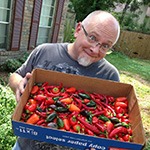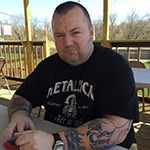 Meet the current contributors to SurvivingPrepper.com. Each brings their own skillset and point of view to the site, from differing regions of the United States. SurvivingPrepper welcomes guest posts, as well as preppers who would like to contribute on a regular basis.
Meet the current contributors to SurvivingPrepper.com. Each brings their own skillset and point of view to the site, from differing regions of the United States. SurvivingPrepper welcomes guest posts, as well as preppers who would like to contribute on a regular basis.
Marc is site owner and writer. Lisa handles editing and images, and writes when possible. Gerald is a Surviving Prepper writer building a monthly column here called “Ready! Set!! Prep!!!” Dan and Diana are living the Homestead life, and write here about the many aspects of self-reliant living. Meet our contributors:

Our first practice attempt at self reliance (learning to grow our own food) was pretty successful. We’re tied to the suburbs of Houston for now, so we made the best of our location and bought a house on a cul-de-sac lot with the intention of finding and buying land in a more remote area as soon as possible. And then we started growing plants that produce food. Citrus and other fruit trees, berry bushes, vegetable gardens, grapes, herbs, and more. In less than a year we turned our back yard into a beautiful and productive oasis within the confines of overcrowded suburbia. But then personal tragedy hit, and our little homestead crashed and burned for nearly two years while we focused on family in another city. Finally, as of summer 2016, we’re beginning to rebuild. Wiser now than we were before. Lessons learned.
I’m Lisa. And for thirty years now, I’ve felt an unease, a nervousness, and a worry about the vulnerability of our society’s reliance on modern technology. I think it’s a good idea to practice self-reliance. And a good idea to prepare for disaster. It just makes sense. Unfortunately, I’ve spent most of my adulthood surrounded by people who think “preppers” are paranoid, overly dramatic wackos, so I’ve had precious few people to practice with. And then I met Marc. Self-reliance, minimalism, and prepping were all philosophies that we bonded over immediately. After we married and got our family settled, we began putting our thoughts and ideas into action.
Luckily, when it came to Homesteading, I didn’t have to start from zero. I spent my childhood learning to shoot guns, grow fruits and vegetables, and preserve food on my grandparents’ farm. Forty acres of piney woods, pasture, a creek, two spring-fed fishing ponds, a herd of cattle, and wild game that ran through it all. They had a big barn filled with great tools, war surplus truck and tractor, a lumber milling setup, and welding equipment. And they knew how to put all of that to work for them. They were real Homesteaders. They built their own home, on their own land, and they fed themselves almost completely from that land. They were children of the Great Depression, and WWII, and the lessons they learned from that hard knock life made them capable of living out their lives on their own, independently. They flourished, and would have had little difficulty continuing to do so if the SHTF during their lifetime. They were prepped, and didn’t even know it.
I want to be prepped. But I don’t like the label “prepper” and I really don’t think of myself as one. Because I’m not about just preparing for (and surviving) disaster. I want to get through the disaster, and its aftermath, to the living again. A homestead where there is safety, and shelter. Water. Gardening. Raising and preserving our own food. Being part of a community where everyone contributes. Living. Together. I don’t want to prep. I want to live. Hopefully, with the support of our family and friends, we can do just that.


Diana grew up in northeastern Montana and was fortunate that her family lived in the same small town where her grandparents had a large farm growing vegetables along with chickens and a small herd of cattle. Summers were spent on the farm in the 20+ acre vegetable garden and 40+ acre sweet corn fields. She helped with canning and preserving the vegetables that were harvested. She learned at an early age from where the meat she ate came. She also learned other domestic skills such as quilting and sewing. Over the years, Diana learned other textile crafts such as spinning, knitting, crocheting, etc.
Dan and Diana both know the value of producing and making the things their family needs, be it food, clothing, or other necessities. They hope that determination and ingenuity will increase their self-sufficiency in years to come.

